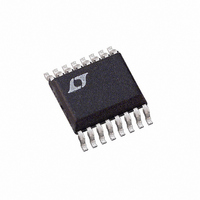LT1950EGN Linear Technology, LT1950EGN Datasheet - Page 6

LT1950EGN
Manufacturer Part Number
LT1950EGN
Description
IC CTLR PWM SGL SWITCH 16-SSOP
Manufacturer
Linear Technology
Datasheet
1.LT1950IGNPBF.pdf
(20 pages)
Specifications of LT1950EGN
Pwm Type
Current Mode
Number Of Outputs
1
Frequency - Max
560kHz
Duty Cycle
97%
Voltage - Supply
3 V ~ 25 V
Buck
No
Boost
Yes
Flyback
Yes
Inverting
No
Doubler
No
Divider
No
Cuk
No
Isolated
Yes
Operating Temperature
-40°C ~ 125°C
Package / Case
16-SSOP
Frequency-max
560kHz
Lead Free Status / RoHS Status
Contains lead / RoHS non-compliant
Available stocks
Company
Part Number
Manufacturer
Quantity
Price
Company:
Part Number:
LT1950EGN
Manufacturer:
LT
Quantity:
10 000
Part Number:
LT1950EGN
Manufacturer:
LINEAR/凌特
Quantity:
20 000
Part Number:
LT1950EGN#PBF
Manufacturer:
LINEAR/凌特
Quantity:
20 000
Part Number:
LT1950EGN#TRPBF
Manufacturer:
LINEAR/凌特
Quantity:
20 000
PI FU CTIO S
LT1950
TYPICAL PERFOR A CE CHARACTERISTICS
6
COMP (Pin 1): The COMP pin is the output of the error
amplifier. The error amplifier is a true op amp which allows
the use of an RC network to be connected between the
Comp and FB pins to compensate the feedback loop for
optimum transient response. The peak switch current in
the external MOSFET will be proportional to the voltage on
the COMP pin. Typical operating voltage range for this pin
is 1V to 2.5V.
FB (Pin 2): The FB pin is the inverting input to the error
amplifier. The output voltage is set with a resistor divider.
The error amplifier adjusts the peak switch current to
maintain the FB pin voltage at the value of the internal
reference voltage of 1.23V.
R
programs the operating frequency of the LT1950. Operat-
ing frequency range is 100kHz to 500kHz. Nominal voltage
on the R
SYNC (Pin 4): The SYNC pin is used to synchronize the
internal oscillator to an external clock signal. The pin is
directly logic compatible and can be driven with any signal
with a duty cycle of 10% to 90%. If the SYNC function is
not used the pin can be left open circuit or connected to
ground.
OSC
700
600
500
400
300
U
–50
BOOST Switch Off Time vs
Temperature
(Pin 3): A resistor from the R
–25
OSC
U
pin is 1V.
0
TEMPERATURE (°C)
25
U
50
75
W
100
1950 G16
U
125
OSC
pin to ground
100
90
80
70
60
50
40
30
0.8
Maximum Duty Cycle vs
V
SEC
1.2
Voltage
MAX DUTY CYCLE = (105/V
1.25V < V
T
A
1.6
V
= 25°C
SEC
VOLTAGE (V)
SEC
2.0
SLOPE (Pin 5): The SLOPE pin is used to adjust the
amount of slope compensation. Leaving the pin open
circuit results in a default level of slope compensation. The
amount of slope compensation can be adjusted above this
default level by connecting a resistor from the SLOPE pin
to the V
V
reference. This pin is capable of sourcing up to 2.5mA for
external use. It is recommended that the V
bypassed to ground with a 0.1µF ceramic capacitor.
SHDN (Pin 7): The SHDN pin is used to put the device into
a low power shutdown state. In shutdown the V
current drops to 5µA. The SHDN pin has an accurate
threshold of 1.32V which can be used to program an
undervoltage lockout threshold. Input current levels on
the SHDN pin can be used to program hysteresis into the
undervoltage lockout levels.
GND (Pin 8): The GND pin is the analog ground for the
internal circuitry of the LT1950. Sensitive circuitry such as
the feedback divider, frequency setting resistor, reference
bypass capacitor should be tied directly to this pin. See the
Applications Information section for recommendations
on ground connections.
< 2.8V
REF
2.4
(Pin 6): The V
REF
2.8
SEC
1950 G17
pin.
)%
3.2
REF
pin is the output of an internal 2.5V
16
15
14
13
12
11
10
–50
GATE Clamp Voltage vs
Temperature
–25
0
TEMPERATURE (°C)
25
50
75
REF
IN
100
supply
pin is
1950 G18
1950fa
125













